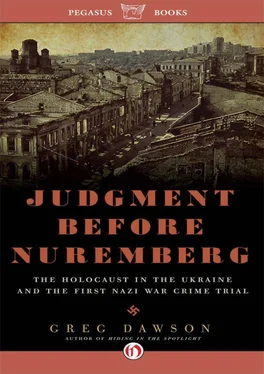The “following orders” mantra was used like table salt on potato pancakes from the top to the bottom of the Nazi war machine, starting with the three mid-level officers chosen by the Soviets for the first war crimes trial in Kharkov in 1943. Later, at Nuremberg, the German generals were asked why they so blindly followed Hitler’s orders to commit acts they knew to be war crimes. General Alfred Jodl said it was “not the task of a soldier to act as judge over his supreme commander. Let history do that or God in Heaven.” Far down the line of command, at the level of sergeant in American terms, Unteroffizier Peter Maiguart, a circus acrobat before the war, repeated the company line, but with more lurid details:
“Our rifles were pointed at the back of the Jews’ heads. I had to shoot a young teenage girl. In German she said to me, ‘How can you murder people?’ I answered, ‘Orders.’ Then I shot her. Altogether I shot twenty-four people that day, maybe more. Others shot more.”
It has been argued that soldiers such as Maiguart followed orders to murder because refusal to do so would mean their own execution or exile to a concentration camp. However, there is a very basic flaw in this argument, noted historian Christopher Browning.
“In the past 45 years no defense attorney or defendant in any of the hundreds of postwar trials has been able to document a single case in which refusal to obey an order to kill unarmed civilians resulted in the allegedly inevitable dire punishment,” Browning wrote in Ordinary Men , his 1992 study of German Reserve Police Battalions which performed many of the same killing tasks as the Wehrmacht and Einsatzgruppen .
To the contrary, Browning and other historians have documented many cases in which German soldiers and officers refused or begged off orders to murder and were given a pass. Sometimes they did not even have to ask. Browning tells the story of conscience-stricken Major Wilhelm Trapp, leader of Reserve Police Battalion 101 sent to execute the Jews of a small Polish village.
“The male Jews of working age were to be separated and taken to a work camp. The remaining Jews—the women, children, and elderly—were to be shot on the spot by the battalion,” Browning wrote. “Having explained what awaited his men, Trapp then made an extraordinary offer: if any of the older men among them did not feel up to the task that lay before him, he could step out.” [1] Christopher Browning, Ordinary Men: Reserve Police Battalion 101 and the Final Solution in Poland (HarperCollins Publishers, New York, 1992), 2.
Only one man stepped out. The rest carried out the bloody orders that day and on many subsequent days, giving the lie to “putative duress,” the notion heard repeatedly from Germans in the dock that they followed criminal orders out of reasonable expectation of punishment if they refused. As Browning notes, after Major Trapp’s tearful offer of immunity, “putative duress did not exist in the battalion”—yet the killing went on without any shortage of killers.
Major Wilhelm was not alone in offering immunity to his men. In her study of auxiliary police units in the Soviet Union, Meredith Meehan writes: “Despite the common misconception that executioners were often ‘ordered to shoot or be shot,’ there is almost no evidence to support this allegation. In fact, one auxiliary noted that, ‘It was made clear to us that we could refuse to obey an order to participate in Sonderaktionen (special actions) without adverse consequences.” [2] Meredith Meehan, “Auxiliary Police Units in the Occupied Soviet Union, 1941–43: A Case Study of the Holocaust in Gomel, Belarus” (Honors thesis, United States Naval Academy, 2010).
This reflected growing awareness in Berlin that point-blank executions were exacting a crippling psychological toll on the shooters. Why else, in planning consummation of the Final Solution, would they switch from bullets in Ukraine to gas in Germany and Poland?
Exemptions were issued from the earliest days of the Nazi Holocaust in Soviet territories. The first traceable killing order of Operation Barbarossa, writes historian Konrad Kwiet, was issued on June 23 or 24, 1946, in Berlin by Heinrich Müller, head of the Gestapo, to SS-Major Hans-Joachim Böhme, head of an Einsatzkommando unit in the East Prussian city of Tilsit. Ultimately, the unit conducted some six thousand executions. Not a single member of the unit hesitated to shoot Jewish men, Kwiet writes, but some drew the line at women and children.
“In late summer of 1941, after a bestial murder of women and children, a police officer declared, ‘I am not doing that again in the future.’ Böhme responded: ‘You will be put in an SS uniform, and you will receive an official order,’ adding later, ‘Fine, you can leave, you do not have to do this—you have a wife and children.’ No one who protested against the murder of Jews or who disobeyed a killing order was ever sentenced to death by the special SS and Police courts. As a rule, such persons were demoted, transferred, or dismissed.”
A prominent example was Erwin Schulz, an Einsatzgruppe commander in Ukraine who asked to be relieved of his duties in the summer of 1941 after receiving orders to increase executions, which might require Schulz himself to kill. The word came down from Himmler that all Jews not engaged in work were to be executed, including women and children. “I was shattered when I heard this piece of news and I had absolutely no doubt that I could never carry out such an order,” Schulz said years later in court. He was released from his duties without penalty.
The true face of the Einsatzgruppen was not the anguished Erwin Schulz but rather the smugly remorseless Ernst Biberstein, a Protestant minister before the war. When asked by the president of the tribunal why—as a professed man of God—he did not provide spiritual balm to those about to be executed, Biberstein replied without hesitation, “Mr. President, one does not cast pearls before swine.”
By the same token, it would be wrong to conclude from examples of the Nazi version of conscientious objection—refusal to quicken the pace of executions—that the German military was rife with reluctant killers. There are many more stories of soldiers who not only followed orders to kill but relished the task, sometimes creatively as with the wine cellars of Artyomovsk. They were guilty of a crime not in the books: aggravated genocide.
“Most men accepted their orders automatically and soon got used to the work,” concluded the editors of The Good Old Days . “Some were positively addicted to it and ‘could not get enough of it.’ Ordinary soldiers of the Wehrmacht who came to watch would sometimes ask to join in, borrowing guns to share in the sport, shooting Jewish children as they ran like hares.” [3] Klee, et al., The Good Old Days , xiii.
A witness to a mass execution in Minsk said the shooters “seemed merry while sitting on top of the execution pits with machine guns and behaved as if they were at a wedding party.”
The willing, even enthusiastic, participation by ordinary soldiers and mid-level officers was instrumental to smooth operation of the Nazi killing machine. “It quickly became apparent that even at the lowest levels in the chain of command there would be no resistance to the shooting orders,” wrote Konrad Kwiet. “On the contrary, the rank and file of the murderous apparatus offered through their actions the clearest evidence of the feasibility of the Final Solution.” [4] Konrad Kwiet, “Rehearsing for Murder: The Beginning of the Final Solution in Lithuania in June 1941,” Holocaust and Genocide Studies (Spring 1998), 11.
Читать дальше












